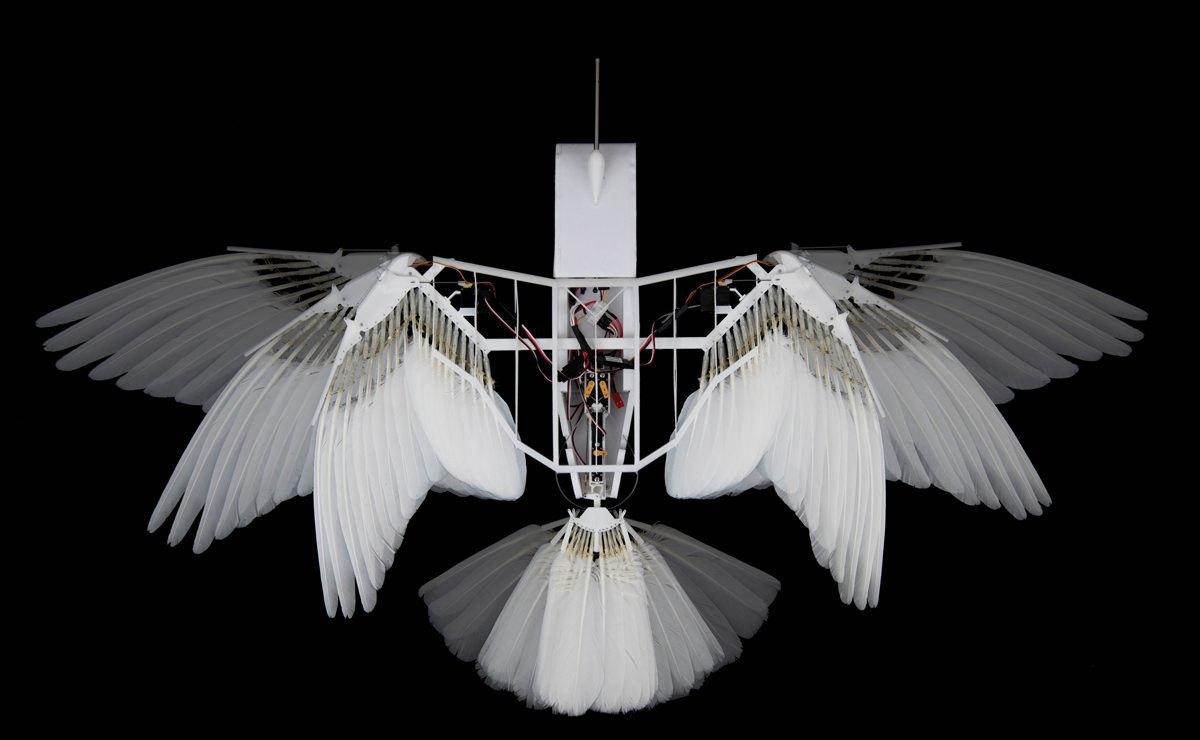Birdlike robot flies steady without a vertical tail
DOI: 10.1063/pt.usov.ggrh

Designed to fly like a bird, PigeonBot II doesn’t rely on a rudder to prevent rolling and yawing. Instead, the wings and tail can shift into multiple positions in response to turbulence. (Image courtesy of Eric Chang, Lentink Lab.)

Unlike birds, most airplanes have a vertical tail. The feature works like a weather vane and prevents the aircraft from rolling and yawing, but it also adds weight, increases drag, and reduces fuel efficiency. Seeking to mimic the flight of birds, David Lentink
Previous studies have shown that birds move their tail feathers in four primary ways: rotation relative to the direction of flight, side-to-side deviation from a neutral position, up and down motions, and feather spreading. Lentink and his team brought the biological research into the engineering regime. They focused on the triggers that spur each of those avian reflexive movements to replicate the responses in a robot.

The tail and wings of PigeonBot II have six controllable degrees of freedom to mimic the movements that birds do reflexively. Corresponding changes to both the wings and the tail feathers allow the robot to fly steadily without a rudder. (Image adapted from E. Chang, D. D. Chin, D. Lentink, Sci. Robot. 9, eado4535, 2024

In the lab, Lentink recognized that birds respond to their environment primarily by adjusting the tilt of their tail based on how fast their yaw angle is changing. A sudden change in position—a large angular velocity vector—causes a proportionally large tail tilt to keep the bird from losing control. To make the correction work, birds couple the tail motion with asymmetric wing spread to simultaneously balance roll. Specifically, the tail of a bird will rotate to essentially become a temporary rudder. The rotation creates sideward-pointing lift in the back that forms a restoring torque to drive the yaw angle back to zero. The flight of the bird steadies, and the tail feathers return to a neutral position. “It’s reorienting the lift vector in a really interesting way,” Lentink says.
Lentink and colleagues applied that understanding to a tethered robot called TailBot and then to PigeonBot II, a new iteration of an earlier flying robot the researchers had developed. The bird-shaped robot with real bird feathers flies autonomously, using changes in both the wings and the tail feathers to respond to position shifts and altitude changes. The wings’ asymmetrical adjustments are able to counter larger-scale roll instabilities, and the tail feathers counter smaller yaw perturbations. The robot can use those same movements to adjust position and to carry out high-level commands given by the researchers, such as to fly higher or to bank left.
There is still work to be done to develop airplanes without a vertical tail. Among other challenges, experiments will need to be carried out to determine how to take the same physics principles and apply them to less flexible airplane wings. Lentink says he is confident that engineers will be up for the task. (E. Chang, D. D. Chin, D. Lentink, Sci. Robot. 9, eado4535, 2024
This article was originally published online on 12 December 2024.
